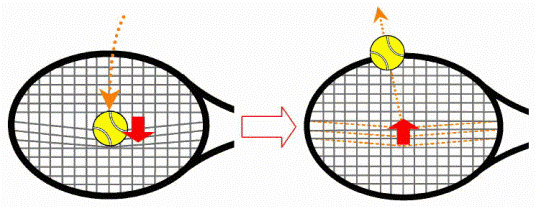Why Hybrid? Role of Main and Cross Strings of Tennis Racket
- GOSEN CANADA

- Dec 9, 2022
- 4 min read
Evolution of Tennis Strings

Since the days when only natural strings were available, tennis stringing materials have continued to evolve since 1954, when GOSEN developed and began selling the world's first synthetic string.
Today, countless types of strings are available, mainly made of nylon and poly, with various combinations of materials, different structures, and processing methods... Already confusing and making it difficult for us to choose the right string. Moreover, what is a hybrid string? Why do some professional players prefer hybrid?
Characteristics of Material & a Rule of Tennis Strings
Here are some rough characteristics of each material.
Natural: Incomparable hitting feeling, poor durability, expensive
Nylon: Soft-hitting feel, good durability, good spin performance
Poly: Hard-hitting feel, best durability, best spin performance
So, did you know that the main strings and cross strings of tennis rackets must be braided together by rule? The rule was triggered by the "Spaghetti Strings" incident.

The History of Hybrid Strings
Tennis in the '70s, when flat strokes were at their peak, as typified by Jimmy Connors (a former GOSEN Contracted player!), the string was required to have a better resilient performance rather than spin performance. So, no one cared about the role of the main and cross strings.
In the '90s, Andre Agassi started using natural x nylon hybrid strings. He later mentioned that he liked the hitting feel of the hybrid strings and that he could control the ball better by reducing the "too much-bouncing feeling" of natural strings.
Various scientific evidence and data have recently clarified the role of the main strings and cross-strings as follows:
Main: Characterizes the string properties and spin performance
Cross: Determines the amount of the main strings moves and hitting feel
The Current Hybrid Strings Trend
Now that spin tennis is in full swing, racket designs are changing, and so are hybrid strings combinations. For instance, Agassi used a racket with a string pattern of main 20 x cross 21. This many-braiding string pattern reduces the "Snap-back" and increases control.

Meanwhile, the current less-braiding string pattern racket (i.e. main 16 x cross 19) promotes spin performance. Poly is the best material to elevate the spin by maximizing the "Snap-back."
So, the current popular hybrid strings pattern (Poly x Nylon) is also designed to promote spin performance. However, it is already known that poly is the best material for spin performance. The downside of the poly is the hard-hitting feel. Meanwhile, nylon is used for the cross string to take advantage of the spin performance of poly, while reducing the hard-hitting feel of poly.
When the ball is hit, this combination causes the slippery main poly string to "snap- back" on the nylon string.

GOSEN's Best Answer on Hybrid
GOSEN has hybrid strings; G-XX series. Conventional hybrids are usually made with thinner gauge poly for the main, and thicker nylon for the cross for durability.
GOSEN G-XX tennis string series uses a thinner gauge AK PRO CX for the cross instead of a thicker gauge. This gives the G-TOUR more "bite," improves resilience, and enhances control.
Pros and Cons of Hybrid Strings
Here is what you can expect from hybrid strings:
Pros
- Great spin performance & softer feeling than poly strings
- Less stress on elbows and joints than poly strings
- Easy to fine-tune the hitting feel by changing the tension of the main and cross strings
Cons
- Difficult to maintain initial tension and hitting feel due to different stretch and durability of the main and cross strings
- Less durable than poly strings
- Difficult to find the right main and cross strings tension that matches your playing style
Not enough yet? Do you want more spin!?
In fact, depending on how they are strung, hybrid strings can bring out spin performance that surpasses that of poly.
Because the main strings move more than the cross strings, durable poly is usually used as the main strings. However, if this combination of main string and cross string is switched (Nylon for main strings / Poly for cross strings), the softer and easier-to-move nylon will "snap-back" more greatly over the poly with less surface resistance, resulting in a much higher spin performance!
As you can imagine, this combination results in very poor durability. Also, the large "snap-back" makes ball control and spin control very difficult.
Federer and Nishikori are stringing their rackets with this spin-first hybrid combination (Natural or Nylon for main strings / Poly for cross strings)... As they are highly skilled, they are able to control the ball at will, and they don't have to worry about the cost and hassle of restringing at all.
Shhh! Don't tell my boss. Do you still want more spin and durability!?

...well, there is a way to increase the spin performance and durability at the same time. It is legal, and tennis professionals like Federer also use this method. Elastocross / String Savers extend string life by preventing notches forming at the intersection of the main and cross strings. The notches are the worst enemies of the "snap-back". Therefore, it also increases the spin performance.
On the negative side, the hitting feel is hardened with this product, which fundamentally reverses the original purpose of the hybrid strings.
Conclusions
If you are struggling to find the right string for your playing style, hybrid is differently worth trying! But beware. Hybrid strings may be the gateway to a new labyrinth...
Postscript
A professional stringer told me that Agassi started using hybrid because the strings in one package were not long enough for the large 107cm2 racket with the main 20 x cross 21 string pattern he was using.
Speaking of Agassi, he married with former world's number one professional tennis player, Steffi Graf. I loved this TV commercial!!










Comments